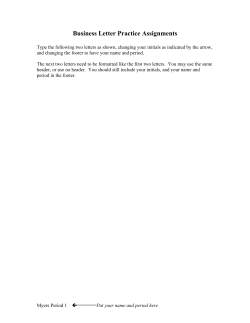
Problem 2A Menu Lesson Print
Lesson Menu Print NAME ______________________________________ DATE _______________ CLASS ____________________ Holt Physics Problem 2A AVERAGE VELOCITY AND DISPLACEMENT PROBLEM The fastest fish, the sailfish, can swim 1.2 × 102 km/h. Suppose you have a friend who lives on an island 16 km away from the shore. If you send a message using a sailfish as a messenger, how long will it take for the message to reach your friend? SOLUTION Given: vavg = 1.2 × 102 km/h ∆x = 16 km Unknown: ∆t = ? Use the definition of average speed to find ∆t. ∆x vavg = ∆t Rearrange the equation to calculate ∆t. ∆x ∆t = vavg 16 km 16 km ∆t = = 2.0 km/min 1h km 1.2 × 102 h 60 min HRW material copyrighted under notice appearing earlier in this book. = 8.0 min ADDITIONAL PRACTICE 1. The Sears Tower in Chicago is 443 m tall. Joe wants to set the world’s stair climbing record and runs all the way to the roof of the tower. If Joe’s average upward speed is 0.60 m/s, how long will it take Joe to climb from street level to the roof of the Sears Tower? 2. An ostrich can run at speeds of up to 72 km/h. How long will it take an ostrich to run 1.5 km at this top speed? 3. A cheetah is known to be the fastest mammal on Earth, at least for short runs. Cheetahs have been observed running a distance of 5.50 × 102 m with an average speed of 1.00 × 102 km/h. a. How long would it take a cheetah to cover this distance at this speed? b. Suppose the average speed of the cheetah were just 85.0 km/h. What distance would the cheetah cover during the same time interval calculated in (a)? Problem 2A 3 Menu Lesson Print NAME ______________________________________ DATE _______________ CLASS ____________________ 4. A pronghorn antelope has been observed to run with a top speed of 97 km/h. Suppose an antelope runs 1.5 km with an average speed of 85 km/h, and then runs 0.80 km with an average speed of 67 km/h. a. How long will it take the antelope to run the entire 2.3 km? b. What is the antelope’s average speed during this time? 5. Jupiter, the largest planet in the solar system, has an equatorial radius of about 7.1 × 104 km (more than 10 times that of Earth). Its period of rotation, however, is only 9 h, 50 min. That means that every point on Jupiter’s equator “goes around the planet” in that interval of time. Calculate the average speed (in m/s) of an equatorial point during one period of Jupiter’s rotation. Is the average velocity different from the average speed in this case? 6. The peregrine falcon is the fastest of flying birds (and, as a matter of fact, is the fastest living creature). A falcon can fly 1.73 km downward in 25 s. What is the average velocity of a peregrine falcon? 7. The black mamba is one of the world’s most poisonous snakes, and with a maximum speed of 18.0 km/h, it is also the fastest. Suppose a mamba waiting in a hide-out sees prey and begins slithering toward it with a velocity of +18.0 km/h. After 2.50 s, the mamba realizes that its prey can move faster than it can. The snake then turns around and slowly returns to its hide-out in 12.0 s. Calculate 8. In the Netherlands, there is an annual ice-skating race called the “Tour of the Eleven Towns.” The total distance of the course is 2.00 × 102 km, and the record time for covering it is 5 h, 40 min, 37 s. a. Calculate the average speed of the record race. b. If the first half of the distance is covered by a skater moving with a speed of 1.05v, where v is the average speed found in (a), how long will it take to skate the first half? Express your answer in hours and minutes. 4 Holt Physics Problem Workbook HRW material copyrighted under notice appearing earlier in this book. a. the mamba’s average velocity during its return to the hideout. b. the mamba’s average velocity for the complete trip. c. the mamba’s average speed for the complete trip. Menu Lesson Print Motion In One Dimension Chapter 2 Additional Practice 2A Givens 1. ∆x = 443 m vavg = 0.60 m/s 2. vavg = 72 km/h ∆x = 1.5 km 3. ∆x = 5.50 × 102 m Solutions ∆x 443 m ∆t = = = 740 s = 12 min, 20 s vavg 0.60 m/s 1.5 km ∆x ∆t = = = 75 s 1h km vavg 72 h 3600 s vavg = 1.00 × 102 km/h 5.50 × 102 m ∆x a. ∆t = = = 19.8 s vavg 1h km 1000 m 1.00 × 102 h 3600 s 1 km vavg = 85.0 km/h b. ∆x = ∆v avg ∆t 1h ∆x = (85.0 km/h) 3600 s 4. ∆x1 = 1.5 km v1 = 85 km/h ∆x1 = 0.80 km Copyright © by Holt, Rinehart and Winston. All rights reserved. v2 = 67 km/h II 103 m (19.8 s) = 468 m 1 km ∆x ∆x a. ∆ttot = ∆t1 + ∆t2 = 1 + 2 v1 v2 1.5 km 0.80 km ∆ttot = + = 64 s + 43 s = 107 s km km 1h 1h 85 67 h 3600 s h 3600 s 1.5 km + 0.80 km 2.3 km ∆x1 + ∆x2 b. v avg = = = = 77 km/h 1h 1h ∆t1 + ∆t2 (64 s + 43 s) (107 s) 3600 3600 s 5. r = 7.1 × 104 km ∆t = 9 h, 50 min ∆x = 2πr ∆x 2π (7.1 × 107 m) 4.5 × 108 m vavg = = = ∆t 60 s 60 s 60 min (9 h) + 50 min (540 min + 50 min) 1 min 1 min 1h 4.5 × 108 m vavg = 60 s (590 min) 1 min vavg = 1.3 × 104 m/s Thus the average speed = 1.3 × 104 m/s. On the other hand, the average velocity for this point is zero, because the point’s displacement is zero. Section Two — Problem Workbook Solutions II Ch. 2–1 Menu Lesson Givens Print Solutions 6. ∆x = –1.73 km ∆t = 25 s 7. vavg,1 = 18.0 km/h ∆t1 = 2.50 s ∆t2 = 12.0 s ∆x –1.73 × 103 m vavg = = = –69 m/s = –250 km/h ∆t 25 s 1h 103 m a. ∆x1 = vavg,1∆t1 = (18.0 km/h) (2.50s) = 12.5 m 3600 s 1 km ∆x2 = –∆x1 = –12.5 m ∆x –12.5 m vavg,2 = 2 = = –1.04 m/s ∆t2 12.0 s ∆x1 + ∆x2 12.5 m + (−12.5 m) 0.0 m = = = 0.0 m/s b. vavg,tot = 14.5 s ∆t1 + ∆t2 2.50 s + 12.0 s c. total distance traveled = ∆x1 – ∆x2 = 12.5 m – (–12.5 m) = 25.0 m total time of travel = ∆t1 + ∆t2 = 2.50 s + 12.0 s = 14.5 s total distance 25.0 m average speed = = = 1.72 m/s total time 14.5 s II 8. ∆x = 2.00 × 102 km ∆t = 5 h, 40 min, 37 s 2.00 × 105 m ∆x 2.00 × 105m a. vavg = = = ∆t 20 437 s 3600 s 60 s 5 h + 40 min + 37 s h min vavg = 9.79 m/s = 35.2 km/h 2.00 × 105 m 1 ∆x = 2∆x ∆x b. ∆t = = = 9.73 × 103 s vavg m (1.05) 9.79 s 1h ∆t = (9.73 × 103 s) = 2.70 h 3600 s 60 min (0.70 h) = 42 min 1h ∆t = 2 h, 42 min II Ch. 2–2 Holt Physics Solution Manual Copyright © by Holt, Rinehart and Winston. All rights reserved. vavg = (1.05)vavg 2
© Copyright 2025










